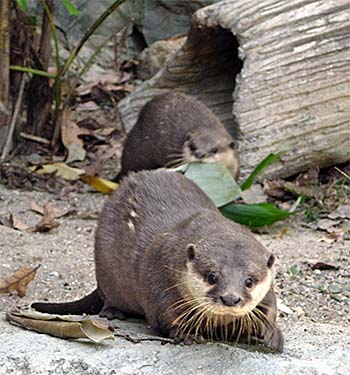
Oriental Small-Clawed Otter
The smallest kind of otter in the world, the Oriental small-clawed otter, is home in whole Southeast Asia northwest of the Wallace Line, and all the way to India and south China. They live in dense vegetation along rivers and sea coasts, including swamps and mangrove forests. They usually avoid vicinity to humans and human settlements.

There is a number of small-clawed otters in the zoo of Songkhla, south Thailand. Image by Asienreisender, 3/2005
The fellows grow up to between 45cm to 61cm without tail, who gains a length of another 25cm to 35cm. Their weight reaches between one to five kilograms. Their webs are not extending the first limb, which allows them to use their fingers well to perform tasks.
Small-clawed otters are very sociable animals. They live in groups around twelve individuals; they play together and communicate with a number of different sounds. Besides, they use scent markings for communication. A peculiar mean of communication is the erection of small mounds which they scrap up by sand, grass or mud.
They use their paws to search the ground for food, and their strong ivory allows them to crack crabs and the shells of other molluscs. They eat vertebrates like mudskippers and other amphibians. Fish (preferably catfish) plays a rather inferiour role in their diet. Here and then they catch a rodent or a snake. They use their paws to bring the food to their mouth. Their activities are diurnal, means they are dayactive animals.

Two Oriental small-clawed otters at the beach of Pangkor Island, Malaysia. Spotting me, they didn't loose time to disappear into the Indian Ocean. Image by Asienreisender, 2/2005
Although they spend most of their time at land, they can swim very well and fast and when diving they can stay under water up to six or even eight minutes.
Pregnancy lasts only two months, then the female gives birth to one or two cubs, sometimes up to six. The cubs are rather undeveloped and helpless in their first weeks. Both parents together build a small nest in the mud where the cubs are kept in the first weeks of their life. Small-clawed otters can have kids twice a year. Their lifespan is eleven to sixteen years.
The rapit habitat destruction in booming Southeast Asia endangers the Oriental small-clawed otters as much as many other animals. Hunting and pollution worsens the situation. The species is classified as 'vulnerable' (threatened) after the criterions of the IUCN.

Another of the fellows, in Songkhla Zoo again. Image by Asienreisender, 3/2005
Sources
This article has been triggered by seeing otters in wildlife on Pangkor Island and in the Areng Valley in Cambodia. I found it at first hard to believe that otters live in the tropes, and a fellow traveller from Scotland also found it hard to believe me that I spotted a couple of them at the banks of the Areng River on a kayak tour. I checked the internet and found some interesting articles about the nice fellows. 'Grzimek's Animal Life Encyclopedia - Mammals' only shortly mentions the species, but, unfortunately, doesn't give it a description.